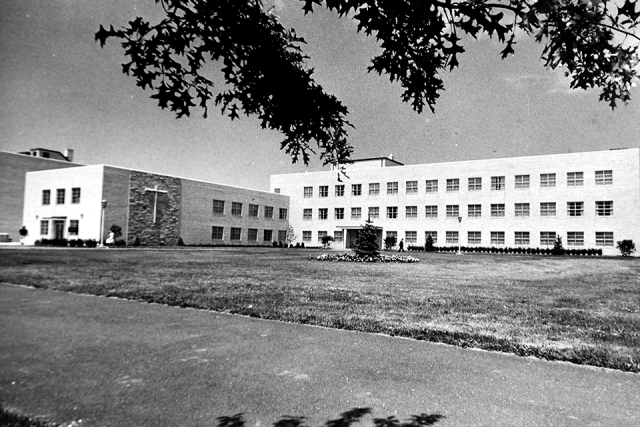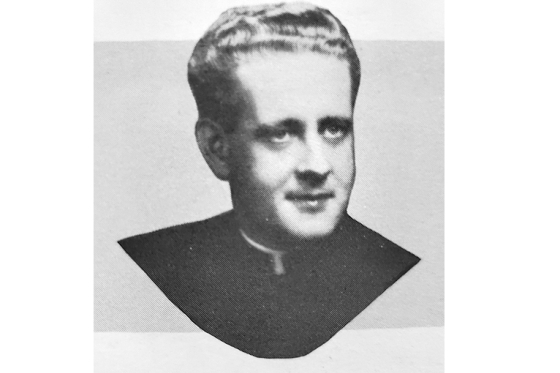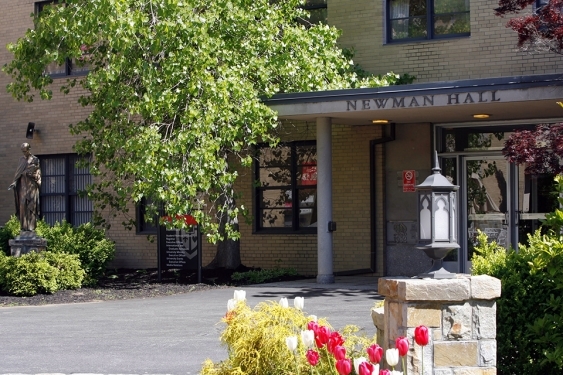
While some of a certain age may associate the singular name Newman with the main antagonist of the long-running, New York City-based NBC sitcom Seinfeld, at St. John’s University, the name is eponymous with administrative leadership, service, and commitment.
The Queens, NY, campus administration building is named after the late Rev. John V. Newman, C.M., a long-serving Vincentian administrator at St. John’s. As one of the oldest campus buildings, Newman Hall was also the first to undergo a name change. When it was first dedicated in 1965, until it was renamed in 1995, it was called Perboyre Hall, a fitting, but often mispronounced, name of a then-beatified Vincentian martyr, Rev. John Gabriel Perboyre, C.M.
Fr. Perboyre was a French priest who served as a missionary in China and is considered the country’s first saint. On campus, the two-syllable French name Perboyre quickly took on a New York flavor and the moniker “Per-boy-ya.”
Fr. Perboyre followed his brother, Louis, and his uncle, Jacques, into the Congregation of the Mission, aka “the Vincentians.” After Louis died en route to evangelize the Chinese, John vowed to take his place. His five years of missionary work were fraught with ill-health, rough travel, the challenge of learning to speak Chinese, and an outbreak of unprecedented persecution against Christians.
While ministering to the poorest Chinese in rural villages, Fr. Perboyre was arrested, tortured, and strangled to death while tied to a cross on September 11, 1840. His path to sainthood advanced when he was beatified on November 10, 1889, by Pope Leo XIII.
Conceived during phase two of the construction plans that mapped out the emerging Queens campus, ground was broken on August 14, 1962, for three new buildings: St. Augustine Hall (library); Marillac Hall (classroom building); and Perboyre Hall.
When it first opened, the L-shaped administration building housed the executive and administrative offices; health offices; student personnel offices; offices of Student Life, the Treasurer and Bursar, and Financial Aid; and a basement computer center featuring oversized IBM mainframes.
Today, the building still houses many administrative and senior leadership offices, including the Office of the President, the Office of the Provost, Business Affairs, Enrollment Management, Information Technology, and newer offices, including the Institute for Critical Race and Ethnic Studies.

Fr. Newman was destined to be a Vincentian. A Brooklyn, NY, native, he was born on July 13, 1913, during the nascent years of St. John’s, and raised in St. John the Baptist Parish, the original site of the University.
He never left the boundaries of his parish for his education, attending the parish parochial school, St. John’s Preparatory School for high school, and college at St. John’s. While a student at St. John’s, Fr. Newman was immersed in activities, usually as an officer, including Associate Editor of The Torch; Editor-in-Chief of The Vincentian yearbook; and Secretary/Treasurer of Skull and Circle; and President of the Crusade Society, the Speakers’ Association, and the Poetry Society.
As an undergraduate, his classmates voted him the student who had “done the most for St. John’s”—a prophecy for his forthcoming priestly ministry that would include 27 years of a 42-year vocation spent as teacher and Vincentian administrator at the Prep and St. John’s.
Fr. Newman entered the novitiate of the Congregation of the Mission three months after his St. John’s graduation in 1935, pronounced his perpetual vows two years later, and pursued his theological studies at St. Vincent’s Seminary, Germantown, and Mary Immaculate Seminary in Northampton, PA. He was ordained with the latter seminary’s first class on May 18, 1940.
Upon ordination, his first appointment returned him appropriately to “the Prep,” where he taught religion and English for 10 years, six years as chairman; coached dramatics and speech; and guided its literary publications. He was named Dean of St. John’s College of Liberal Arts and Sciences and a University Board of Trustees member in 1950.
Fr. Newman served until 1956, when he went to the Vincentian minor seminary at Princeton, NJ, for the next 17 years, 15 of them as Vice President and Dean. In 1971, he returned to St. John’s as Special Assistant to the President, adding the office of Vice President for Alumni Affairs and Auxiliary Services in 1979.

Because so much of his ministry was spent in education and seminary formation, Fr. Newman was a beloved confrere to generations of Vincentians and countless St. John’s alumni. He was often referred to as the “memory bank” of St. John’s, and his unwavering commitment was recognized with the University’s Pietas, President’s Medals, and the Medal of Honor shortly before he succumbed to a brief battle with cancer and died on July 28, 1982. A convocation in his honor and his funeral attracted standing-room-only crowds to Marillac Auditorium.
On January 25, 1995, Perboyre Hall was renamed Newman Hall in honor of Fr. Newman. One year later, Pope John Paul II officially announced the canonization of Blessed Rev. John Gabriel Perboyre, C.M. A statue of St. John Gabriel Perboyre appears in the first-floor lobby of Newman Hall alongside his photo. They are two Vincentians bound by history and service to others.
Related News
St. John’s ROTC Program Prepares Next Generation of Army Leaders
St. John’s University’s Army Reserve Officers’ Training Corps (ROTC) program experienced a changing of the guard earlier this year when 19-year United States Army officer Lt. Col. Matthew Pride and...
Alumna Celebrates Book Launch After Career Change
After developing a passion for helping the younger generation, Ashley Wilson ’14M.S.Ed. pivoted from a career in the music industry to work as an educator. She is also making her mark through her new...
Christmas Card 2025
A Christmas message from Rev. Brian J. Shanley, O.P., President of St. John’s University.
